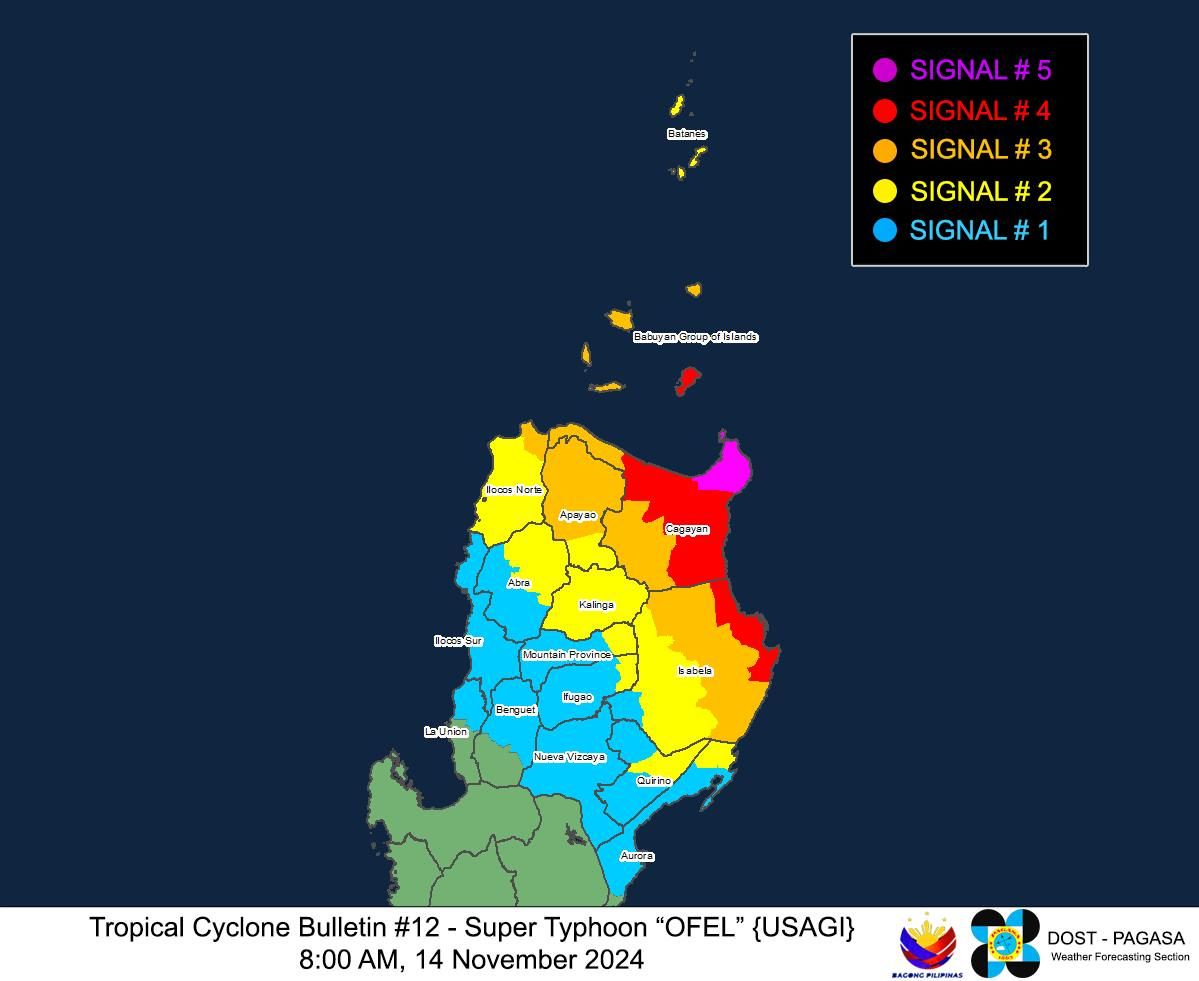'Ofel' intensifies into super typhoon; Signal No. 5 raised
At A Glance
- PAGASA said Ofel may continue to move northwestward over the Philippine Sea before making landfall along the eastern coast of Cagayan or northern Isabela Thursday afternoon.
- The super typhoon will likely emerge over the Babuyan Channel Thursday evening, potentially making another landfall or close approach to Babuyan Islands.

Tropical cyclone “Ofel” (international name: Usagi) has rapidly intensified into a super typhoon, prompting the Philippine Atmospheric, Geophysical and Astronomical Services Administration (PAGASA) to raise Signal No. 5 due to the potential for extreme impacts in the coming hours.
According to PAGASA’s 8 a.m. bulletin on Thursday, Nov. 14, Ofel now has maximum sustained winds of 185 kilometers per hour (kph) near its center and gusts reaching 230 kph. Previously classified as a typhoon, Ofel had maximum sustained winds of 165 kph and gusts of 205 kph.
At around 7 a.m., the center of the super typhoon was located 165 kilometers east-southeast of Tuguegarao City, Cagayan.
As Ofel approaches, Signal No. 5 has been raised over the northeastern portion of mainland Cagayan, where extreme impacts from typhoon-force winds are expected.
Signal No. 4 is raised over the southeastern portion of Babuyan Islands (Camiguin Island), northern and eastern parts of mainland Cagayan (Santa Teresita, Ballesteros, Aparri, Camalaniugan, Buguey, Lal-Lo, Allacapan, Gattaran, Baggao, Peñablanca) and northeastern Isabela (Maconacon, Divilacan, Palanan), where “significant to severe impacts from typhoon-force winds” are likely.
Signal No. 3 is in effect over the rest of Babuyan Islands, the rest of Cagayan, northern, central, and southeastern parts of Isabela (San Pablo, Delfin Albano, Ilagan City, Tumauini, Cabagan, Santa Maria, Santo Tomas, San Mariano, Dinapigue), northern Apayao (Flora, Santa Marcela, Luna, Pudtol, Calanasan, Kabugao), and northern portion of Ilocos Norte (Pagudpud, Adams, Dumalneg), with “moderate to significant impacts” from storm-force winds expected.
Meanwhile, Signal No. 2 is up over Batanes, western and southern portions of Isabela (Quezon, Quirino, Mallig, San Manuel, Aurora, Cabatuan, City of Cauayan, Benito Soliven, Naguilian, Gamu, Burgos, Reina Mercedes, Luna, Roxas, Angadanan, Alicia, San Guillermo, Echague, Jones, San Agustin, San Mateo, San Isidro), northeastern part of Quirino (Maddela), the rest of Apayao, Kalinga, northeastern portion of Abra (Tineg, Lacub, Malibcong, Lagayan, San Juan, Lagangilang, Licuan-Baay, Daguioman), eastern part of Mountain Province (Paracelis), eastern Ifugao (Alfonso Lista), the rest of Ilocos Norte, and of Aurora (Dilasag), where gale-force winds could cause “minor to moderate impacts.”
Areas under Signal No. 1 are the rest of Isabela, the rest of Quirino, Nueva Vizcaya, the rest of Mountain Province, the rest of Ifugao, the rest of Abra, northern Benguet (Bokod, Mankayan, Kapangan, Atok, Kabayan, Kibungan, Bakun, Buguias, Tublay), Ilocos Sur, northern part of La Union (Luna, Sudipen, Bangar, Santol, San Gabriel, Bagulin, Bacnotan, Balaoan, San Juan), and northern and central portions of Aurora (Casiguran, Dinalungan, Dipaculao, Maria Aurora, Baler, San Luis), with “minimal to minor impacts” from strong winds.
Landfall
PAGASA said Ofel may continue to move northwestward over the Philippine Sea before making landfall along the eastern coast of Cagayan or northern Isabela Thursday afternoon.
The super typhoon will likely emerge over the Babuyan Channel Thursday evening, potentially making another landfall or close approach to Babuyan Islands.
PAGASA warned that, regardless of the exact landfall location, hazardous conditions could still affect areas outside the landfall point and the forecast confidence cone.
Flood, landslide risks
PAGASA said intense to torrential rainfall (over 200 millimeters) may affect Cagayan and Isabela in the next 24 hours.
Heavy to intense rains (100 to 200 millimeters) could also affect Batanes, Ilocos Norte, Apayao and Kalinga, while moderate to heavy rainfall (50 to 100 millimeters) may prevail over Abra, Mountain Province, Ifugao, Quirino, Nueva Vizcaya, and Aurora.
The weather bureau warned that these conditions could lead to flooding and landslides, particularly in areas highly susceptible to such hazards and those with significant previous rainfall.